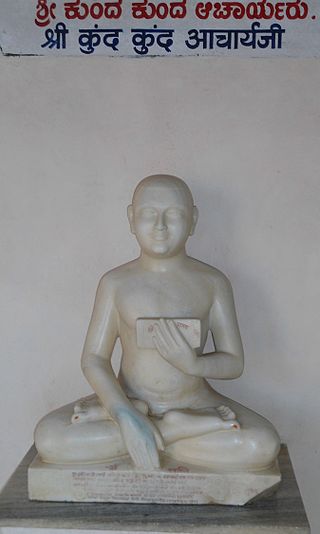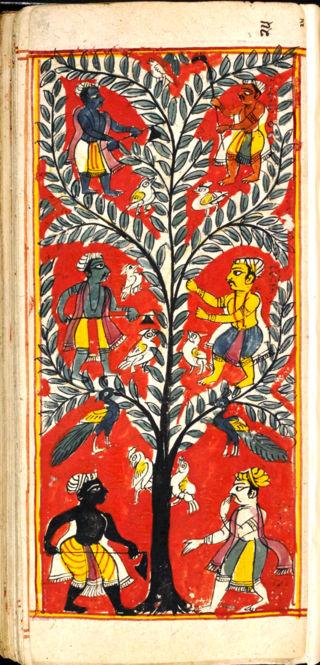
Asceticism is a lifestyle characterized by abstinence from sensual pleasures, often for the purpose of pursuing spiritual goals. Ascetics may withdraw from the world for their practices or continue to be part of their society, but typically adopt a frugal lifestyle, characterised by the renunciation of material possessions and physical pleasures, and also spend time fasting while concentrating on the practice of religion or reflection upon spiritual matters, which is thought by some to allow the practitioner's core of consciousness to expand and connect with the infinite universal consciousness. Some individuals have also attempted an ascetic lifestyle to free themselves from addictions to things such as alcohol, tobacco, drugs, entertainment, sex, food, etc.

Mahavira, also known as Vardhamana, was the 24th Tirthankara of Jainism. He was the spiritual successor of the 23rd Tirthankara Parshvanatha. Mahavira was born in the early 6th century BCE to a royal Jain family of ancient India. His mother's name was Trishala and his father's name was Siddhartha. They were lay devotees of Parshvanatha. Mahavira abandoned all worldly possessions at the age of about 30 and left home in pursuit of spiritual awakening, becoming an ascetic. Mahavira practiced intense meditation and severe austerities for twelve and a half years, after which he attained Kevala Jnana (omniscience). He preached for 30 years and attained moksha (liberation) in the 6th century BCE, although the year varies by sect.

The Śvetāmbara is one of the two main branches of Jainism, the other being the Digambara. Śvetāmbara in Sanskrit means "white-clad", and refers to its ascetics' practice of wearing white clothes, which sets it apart from the Digambara or "sky-clad" Jains whose ascetic practitioners go nude. Śvetāmbaras do not believe that ascetics must practice nudity.
Shastra is a Sanskrit word that means "precept, rules, manual, compendium, book or treatise" in a general sense. The word is generally used as a suffix in the Indian literature context, for technical or specialized knowledge in a defined area of practice.

Tapas is a variety of austere spiritual meditation practices in Indian religions. In Jainism, it means asceticism ; in Buddhism, it denotes spiritual practices including meditation and self-discipline; and in the different traditions within Hinduism it means a spectrum of practices ranging from asceticism, inner cleansing to self-discipline by meditation practices. The Tapas practice often involves solitude and is a part of monastic practices that are believed to be a means to moksha.

The Kalpa Sūtra is a Jain text containing the biographies of the Jain Tirthankaras, notably Parshvanatha and Mahavira. Traditionally ascribed to Bhadrabahu, which would place it in the 4th century BCE, it was probably put in writing 980 or 993 years after the Nirvana (Moksha) of Mahavira.

Parshvanatha, or Pārśva and Pārasanātha, was the 23rd of 24 Tirthankaras of Jainism. He gained the title of Kalīkālkalpataru.

Ācārya Bhadrabāhu was, according to both the Śvetāmbara and Digambara sects of Jainism, the last Shruta Kevalin in Jainism.

Tattvārthasūtra, meaning "On the Nature [artha] of Reality [tattva]" is an ancient Jain text written by Acharya Umaswami in Sanskrit, sometime between the 2nd- and 5th-century CE.

Jain monasticism refers to the order of monks and nuns in the Jain community and can be divided into two major denominations: the Digambara and the Śvētāmbara. The monastic practices of the two major sects vary greatly, but the major principles of both are identical. Five mahāvratas, from Mahavira's teachings, are followed by all Jain ascetics of both the sects. Historians believe that a united Jain sangha (community) existed before 367 BCE, about 160 years after the moksha (liberation) of Mahavira. The community then gradually divided into the major denominations. However, no evidences indicate when the schism between the Digambaras and the Śvetāmbaras happened.
According to Jainism, Ātman (soul) is eternal and never dies. According to Tattvartha Sutra which is a compendium of Jain principles, the function of matter (pudgala) is to contribute to pleasure, suffering, life and death of living beings.
Pravacana is a term for any exposition of a doctrine or treatise, or to the recitation of a scripture or text in Jainism and Hinduism traditions. It particularly refers to the tradition of Pravacanakara presenting their teachings or explanations of spiritual ideas before a gathering of householders or general public in the Indian traditions. Pravacana is an ancient tradition, whose earliest mentions are found in the Vedic texts but one that is also found in post-Vedic Shastra and Sutra texts of Hindus and Jains.
Tapa Gaccha is the largest Gaccha of Svetambara Jainism.
The Acharanga Sutra is the first of the twelve Angas, part of the agamas which were compiled based on the teachings of 24th Tirthankara Mahavira.
Jainism is a religion founded in ancient India. Jains trace their history through twenty-four tirthankara and revere Rishabhanatha as the first tirthankara. The last two tirthankara, the 23rd tirthankara Parshvanatha and the 24th tirthankara Mahavira are considered historical figures. According to Jain texts, the 22nd tirthankara Neminatha lived about 5,000 years ago and was the cousin of Krishna.

Sanskrit moksha or Prakrit mokkha refers to the liberation or salvation of a soul from saṃsāra, the cycle of birth and death. It is a blissful state of existence of a soul, attained after the destruction of all karmic bonds. A liberated soul is said to have attained its true and pristine nature of infinite bliss, infinite knowledge and infinite perception. Such a soul is called siddha and is revered in Jainism.

Jain literature refers to the literature of the Jain religion. It is a vast and ancient literary tradition, which was initially transmitted orally. The oldest surviving material is contained in the canonical Jain Agamas, which are written in Ardhamagadhi, a Prakrit language. Various commentaries were written on these canonical texts by later Jain monks. Later works were also written in other languages, like Sanskrit and Maharashtri Prakrit.

Lesya, according to the Jain theory of karma, is the coloring of the soul on account of its association with the karmic matter. The colour of leśyā varies from person to person depending on the psychic states and mental activities behind an action. The coloring of the soul is explained through the analogy of crystal, that acquires the color of the matter associated with it. In the same way, the soul reflects the qualities of colour, taste, smell and touch of associated karmic matter, although it is usually the colour that is referred to when discussing the leśyās. Paul Dundas notes the key text expressing this Jain doctrine, explaining how the literary form of the text is helpful in dating and reconstructing the history of transmission.
A full statement of the theory of lesya occurs in chapter 34 of the Uttaradhyayana, one of the fundamental sutras of the scriptural canon. Inspection of the metrical structure there, which consists of a cluster of old sloka verses amplified by twice as many verses in the arya metre, makes clear that a great deal of ancient editorial care was taken to ensure that an original rudimentary description of this dimension of karma became fully cogent.

Kharatara Gaccha is one of Shvetambara Murtipujaka Gacchas. It is also called the Vidhisangha or Vidhimarga, as they regard their practices as scripturally correct.
Jainism and Hinduism are two ancient Indian religions. There are some similarities and differences between the two religions. Temples, gods, rituals, fasts and other religious components of Jainism are different from those of Hinduism.















